
Coventry is a city, administrative centre and metropolitan borough in England and the United Kingdom. It is built on the River Sherbourne, which remains largely hidden by infrastructure, although it can be seen by the canal. Coventry has been a large settlement for centuries, although it was not founded and given its city status until the Middle Ages; since then it has been one of the most important and largest cities of the country. The conurbation consists of the Coventry and Bedworth Urban Area, being the 20th largest in the country; the city is governed by Coventry City Council.
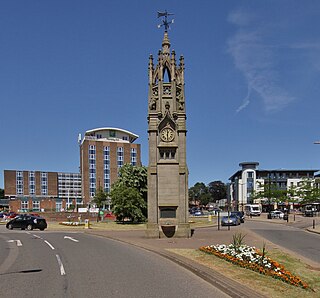
Kenilworth is a market town and civil parish in Warwickshire, England; it is situated approximately 6 miles (10 km) south-west of central Coventry, 5 miles (8 km) north of Warwick and 90 miles (140 km) north-west of London. It lies on Finham Brook, a tributary of the River Sowe, which joins the River Avon about 2 miles (3 km) north-east of the town centre. The 2011 Census recorded a parish population of 22,413. The town is noted architecturally for the extensive ruins of Kenilworth Castle, the ruins of Kenilworth Abbey in Abbey Fields park, St Nicholas's Parish Church and the town's clock tower.
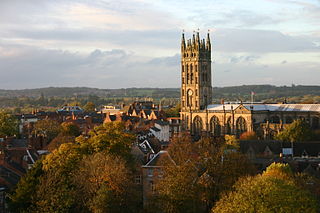
Warwick is a market town and county town of Warwickshire, England. It lies near the River Avon, 11 miles (18 km) south of Coventry and west of Leamington Spa and Whitnash. Its population was 31,345 in 2011. Signs of Neolithic activity precede unbroken habitation to the 6th century AD. It was a Saxon burh in the 9th century; Warwick Castle was built during the Norman conquest of England. Warwick School claims to be the country's oldest boys' school. The earldom of Warwick, created in 1088, controlled the town and built its walls, of which Eastgate and Westgate survive. The castle became a fortress, then a mansion. The Great Fire of Warwick in 1694 destroyed much of the town. Warwick missed industrialisation, but the population has grown almost sixfold since 1801.
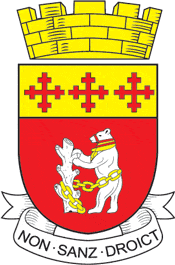
This is about the history of the county Warwickshire situated in the English Midlands. Historically, bounded to the north-west by Staffordshire, by Leicestershire to the north-east, Northamptonshire to the east, Worcestershire to the west, Oxfordshire to the south and Gloucestershire to the south-west. Areas historically part of Warwickshire include Coventry, Solihull, Sutton Coldfield and a small area of central Birmingham including Aston and Edgbaston. These became part of the metropolitan county of West Midlands following local government re-organisation in 1974 after the passage of the Local Government Act 1972.

Amroth is both a village, a parish and a community. Located 7 miles (11 km) north-east of Tenby, Pembrokeshire, Wales, it is noted for its long sandy beach. The name is Welsh, and probably means "on Rhath". Amroth lies in the Pembrokeshire Coast National Park and is the south-eastern start of the Pembrokeshire Coast Path.

Baginton is a village and civil parish in the Warwick district of Warwickshire, England, and has a common border with the City of Coventry / West Midlands county. With a population of 801, Baginton village is 4 miles south of central Coventry, 4.5 miles northeast of Kenilworth and 7 miles north of Leamington Spa. The population had reduced slightly to 755 at the 2011 Census. The Lucy Price playing field is situated centrally in the village.

Clan Sutherland is a Highland Scottish clan whose traditional territory is the shire of Sutherland in the far north of Scotland. The chief of the clan was also the powerful Earl of Sutherland, however in the early 16th century this title passed through marriage to a younger son of the chief of Clan Gordon. The current chief is Alistair Sutherland who holds the title Earl of Sutherland.

Kilravock Castle is located near the village of Croy, between Inverness and Nairn, in the council area of Highland, Scotland. It was begun around 1460 and has been the seat of the Clan Rose since that time. The castle is a composite of a 15th-century tower house and several later additions. The original name for the castle was Cill Rathaig; Scottish Gaelic meaning "church at the small circular fort".
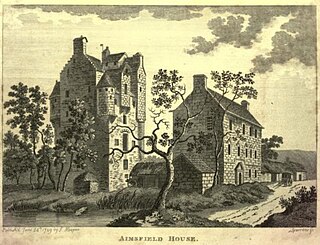
Amisfield Tower is a well-preserved tower house near Tinwald, about 5 miles (8.0 km) north of Dumfries, in Dumfries and Galloway, south-west Scotland. The castle has also been known as Hempisfield Tower. It is a Category A listed building.

Wyken, a suburb of Coventry, West Midlands, England, is situated between the areas of Stoke and Walsgrave, three miles east-northeast of Coventry city centre. The population of this Coventry Ward taken at the 2011 census was 16,818. It is a fairly large ward spreading as far as the Binley area. The majority of the houses in Wyken are terraced houses.

Kildrummy is a hamlet in Aberdeenshire, Scotland near the River Don, 7 miles west of Alford. The hamlet's primary school closed in 2003.
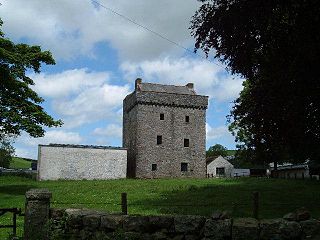
Drumcoltran Tower is a late-16th-century tower house situated in the historical county of Kirkcudbrightshire near Kirkgunzeon, Dumfries and Galloway.

Barclosh Castle is a ruined 16th-century tower house situated near Dalbeattie, Dumfries and Galloway. There remains a section of wall 4 feet thick and 27 feet high.

Liddel Castle is a ruined castle in Liddesdale, by the Liddel Water, near Castleton in the Scottish Borders area of Scotland, in the former county of Roxburghshire. Liddel Castle is a scheduled monument.

Caludon Castle is a Scheduled Ancient Monument and Grade I listed building in Coventry, in the West Midlands of England. A second moated site 190 metres (620 ft) to the south is a Scheduled Ancient Monument in its own right. The castle is now a ruin, and all that remains is a large fragment of sandstone wall. What remains of the estate is now an urban park, owned and run by Coventry City Council, but much of it was sold and developed into housing estates in the early 20th century.

The Murrays of Aberscross were a minor noble Scottish family who were seated at Aberscross Castle, in the county of Sutherland, Scotland.
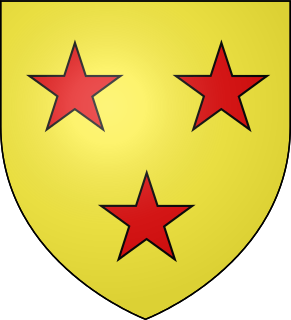
The Battle of Torran-Roy was a Scottish clan battle that took place in the year 1570 in the county of Sutherland, Scotland. It was fought between the forces of Alexander Gordon, 12th Earl of Sutherland and the forces of George Sinclair, 4th Earl of Caithness. The Earl of Sutherland's force consisted primarily of the Murrays of Aberscross who despite their name were not part of the Clan Murray in Atholl, but who were a sept of the Clan Sutherland, and who as the principal vassals of the Earl of Sutherland, were charged with the defense of the shire. The Earl of Caithness's forces consisted primarily of followers of the Sutherland Laird of Duffus who was a descendant of the old de Moravia/Sutherland Earls of Sutherland who had been ousted and replaced by the Gordons as earls in the early 16th-century.

The site of the old Lefnoreis Castle or Ward of Lochnorris lies about 100 yards north-west of the old stable block of Dumfries House in East Ayrshire, Parish of Old Cumnock, Scotland. The old castle stood on a natural rise overlooking the Lugar Water, built and held for many years by the Craufurd family. For consistency the spelling Craufurd will be used throughout and Lefnoreis for the castle.
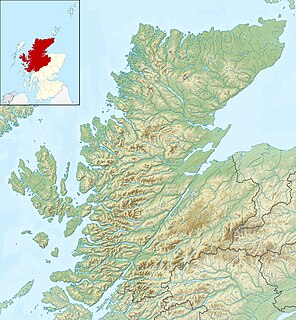
Scrabster Castle was a castle near the village of Scrabster, Highland in Scotland.



















